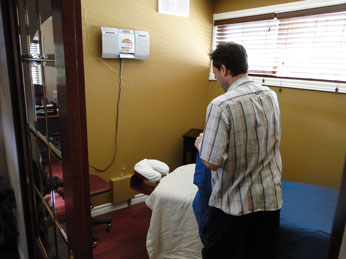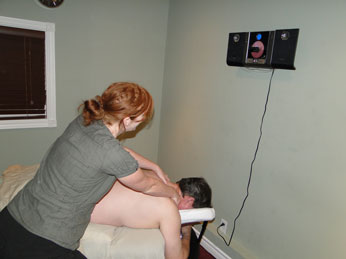Massage
To book an appointment please click here!
Scope of Practice
The practice of massage therapy is the assessment of the soft tissue and joints of the body and the treatment and prevention of physical dysfunction and pain of the soft tissue and joints by manipulation to develop, maintain, rehabilitate or augment physical function, or relieve pain. (Massage Therapy Act 1991)
Massage can be very different with regards to the technique used and the personal experience of the therapist performing it.
Swedish massage
Developed in 1812 by Per Henrik Lik, Swedish massage uses oils so that strokes can be smooth and gliding. With Swedish massage, your body is manipulated through a rolling movement of the fingers combined with tapping and vibration.
Swedish massage involves five different movements which give a gentle but firm pressure. Effleurage are long strokes from your neck to the base of your spine or from your shoulder to your fingertips. Petrissage means rolling and squeezing your muscles while gently lifting them from your bones. It includes kneading and pressing. Friction uses deep circular movements while tapotement involves striking or tapping the muscles.
Vibration involves using hand movements to shake the back or arms and legs. Used in combination these movements can have a powerful effect. The process is not painful and oils are used to prevent friction.
What are the benefits?
A form of therapy that is known for its ability to reduce stress levels as well as to heal. This treatment is particularly effective for relieving musclular aches and pains. It improves your circulation as well as being very relaxing and releasing tension. It helps to clear toxins from your nervous system and your muscles.
It’s very good for lower back pain as well as easing neck stiffness. By manipulating the muscles, the flow of oxygen and nutrients is greatly improved. It can reach deep lying tension that other treatments fail to address and is very popular with those seeking to cope with busy, modern lives.
Connective Tissue Massage
The treatment by connective tissue massage is a form of massage which concentrates on the fascia. This is a type of tissue which forms a sheath that gives structural support to your skeleton and your soft tissues, such as muscles and tendons. Connective tissue massage aims to relax the fascia and restore your body’s natural balance.
The idea being that as a result of trauma or injury, your fascia can constrict and shorten even when you try to relax. Connective tissue massage is aimed at restoring the length of your fascia or myofascial tissue so that it regains flexibility. Practitioners don’t use oils but instead concentrate on slow, deep reaching movements that have long lasting effects. It’s very relaxing and not painful. The idea is that your therapist is working with you and not on you, so it’s key that you let them know how your feeling.
What are the benefits?
It reduces chronic tension. This can lead to improved posture and greater physical movement as well as a better sense of emotional well being. The body is worked on as an entire entity and as physical stress is released, there can be a sense of opening up in terms of emotional space as well. This can improve your breathing, your sense of self awareness, and give a feeling of letting go of physical and emotional tension.
It’s popular with athletes and dancers as it’s useful in healing injuries quicker and preventing possible pulls or strains in the future. Chronic illnesses such as multiple sclerosis, chronic fatigue syndrome and arthritis, have also been eased by its use. It’s deeply relaxing and you don’t need to have a specific problem in order to benefit.
Pregnancy Massage
Pregnancy massage is intended to relieve the stressful forces that are placed on the body during pregnancy, including:
- The presence of the baby in-womb causes a rapid increase in a woman’s center of gravity which results in postural and ergonomic stresses being placed on the body, commonly showing as (though not limited to) as pain in the low back and buttocks. Soft tissue work can help to relax these strained muscles, helping to not only reduce pain during the pregnancy but also allow the body a faster recovery post-pregnancy as the body returns to ‘normal’.
- These postural changes also cause stresses on the vascular (circulation) systems of the body. The results of this can result in either less blood getting to a part of the body or a reduction in the return of these fluids back to the core of the body. This causes these areas of the body to become prone to either feeling cold or swelling respectively. A common area that women find affected by this are the lower legs and feet or even the hands. Circulatory work done during pregnancy massage can help relieve both of these conditions.
- During pregnancy a woman’s hormone levels adjust causing joint ligaments increase in laxity to allow for an easier birthing. This however can cause joints to become more unstable and more prone to subluxation (partial dislocation) and result in pain. Light joint mobilizations performed post-pregnancy to help re-align any subluxed joints before the hormonal levels change the again and the ligaments retighten, trapping and keeping these subluxed joints misaligned. The pelvis is a common site where this occurs, as it is forced to become highly mobile during the birthing process.
- Stress itself can cause many complications in anyone’s life, and due to constant physical and physiological changes pregnant women are even more prone to being affected by it. Pregnancy massage, just like a classic relaxation massage can greatly reduce the physical and emotional stresses. Keeping stress levels down can not only increase short term comfort but also help to reduce or even prevent certain birthing complications either caused by or compounded by increased stress levels.
